The demand for pea grits in the USA is projected to reach USD 593.8 million by 2035, reflecting an absolute increase of USD 246.5 million over the forecast period. The demand, valued at USD 347.3 million in 2025, is expected to grow at a CAGR of 5.50%. This growth is primarily driven by the increasing adoption of plant-based protein sources and the rising popularity of pea-based products, particularly in the food and beverage, dietary supplement, and alternative protein sectors.
The growth rate volatility index for pea grits in the USA is expected to show fluctuations, with steady growth initially and a significant acceleration towards the latter half of the forecast period. Between 2025 and 2030, the growth rate will remain relatively stable, with a consistent increase in demand driven by rising awareness of plant-based proteins and the growing popularity of pea-based products. The volatility during this phase is expected to be low, as demand for pea grits grows steadily, supported by a steady increase in the adoption of plant-based diets and more mainstream acceptance of pea protein.
Between 2030 and 2035, the growth rate is expected to become more volatile, with a significant increase in demand. This period will be marked by innovations in food formulations and greater mainstream adoption of plant-based foods, which will contribute to a sharp rise in demand for pea grits. As the plant-based food sector expands rapidly, the growth rate may experience spikes due to the surge in new product introductions and increased consumer interest in plant-based proteins. This volatility is a reflection of broader industry trends as consumer behavior shifts and demand for alternative protein sources reaches new heights, driving the demand for pea grits upwards.

Between 2025 and 2030, the demand for pea grits in the USA is projected to grow from USD 347.3 million to approximately USD 366.4 million, adding USD 19.1 million, which accounts for about 7.7% of the total forecasted growth for the decade. This period will see steady growth driven by increased consumer interest in plant-based products and rising awareness of the health benefits of plant proteins.
From 2030 to 2035, the demand is expected to expand from approximately USD 366.4 million to USD 593.8 million, adding USD 227.4 million, which constitutes about 92.3% of the overall growth. This phase will be marked by accelerated adoption, particularly in the plant-based food sector, as more companies launch new products that incorporate pea grits as a primary ingredient. The demand will also be driven by innovations in food formulations and further awareness of the environmental benefits of plant-based proteins.
| Metric | Value |
|---|---|
| USA Pea Grits Value (2025) | USD 347.3 million |
| USA Pea Grits Forecast Value (2035) | USD 593.8 million |
| USA Pea Grits Forecast CAGR (2025-2035) | 5.50% |
The demand for pea grits in the USA is growing due to the increasing popularity of plant-based proteins and the rising consumer preference for gluten-free, non-GMO, and high-protein ingredients in food products. Pea grits, which are made from dried yellow peas, are a versatile ingredient used in a variety of applications, including snacks, soups, and plant-based meat alternatives. As more consumers shift towards plant-based diets, the demand for pea-based ingredients such as pea grits is on the rise.
The growing awareness of the health benefits of plant-based diets, combined with the rising concerns about the environmental impact of animal-based products, is contributing to the expansion of the pea grits industry. Pea grits are an excellent source of protein, fiber, and essential amino acids, making them a preferred ingredient in health-conscious food products. The trend of incorporating more plant-based ingredients into daily meals, including in the form of protein-rich snacks and meat substitutes, is further driving demand for pea grits.
The increased focus on sustainable food production methods is supporting the growth of pea-based ingredients. Peas require fewer resources to grow compared to traditional animal protein sources, making them an attractive option for manufacturers looking to reduce their environmental footprint. Despite challenges such as the need for better processing technologies and competition from other plant-based ingredients, the demand for pea grits is expected to grow steadily as consumers continue to prioritize health and plant-based food options.
Demand is segmented by product type, end use, flavor, and distribution channel. By product type, demand is divided into yellow pea grits and green pea grits. Based on end use, demand is categorized into food processing, poultry feeds, food services, households, and others. In terms of flavor, demand is divided into sweet and savory. Regionally, demand is divided into the West, South, Northeast, and Midwest.

Yellow pea grits account for 62% of the demand for pea grits in the USA. Yellow peas are the most widely grown and processed type of pea in the USA, making yellow pea grits the dominant product. Yellow pea grits are preferred for their neutral flavor, which makes them suitable for a wide variety of applications in food processing, particularly in the production of snacks, cereals, and plant-based protein products.
The versatility of yellow pea grits, coupled with their ability to provide a high-quality source of protein and fiber, has made them a popular choice for both manufacturers and consumers. They are also widely used in the production of plant-based foods due to their functional properties, such as their ability to improve texture and consistency. As consumer demand for plant-based products continues to rise, yellow pea grits are expected to maintain their leadership in the industry.
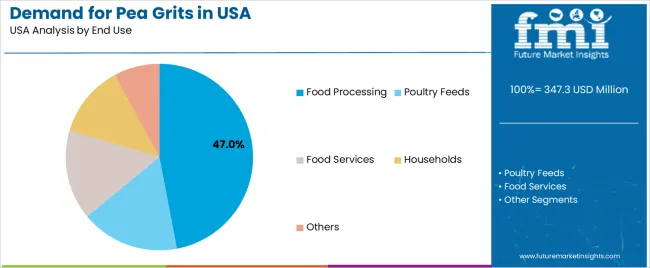
The food processing sector accounts for 47% of the demand for pea grits in the USA. Pea grits are widely used in food processing due to their high nutritional value and versatility. They serve as an important ingredient in various food products such as plant-based protein foods, protein bars, baked goods, and snacks. The growing consumer demand for plant-based and protein-enriched products is driving the need for pea grits in the food processing industry.
The increasing awareness of the health benefits of peas, such as their high protein and fiber content, is further fueling demand. Pea grits are also used as a thickening agent and a binder in processed food applications, making them an integral part of the food processing industry. As plant-based foods become more popular, food processors are turning to pea grits as a reliable, sustainable, and cost-effective ingredient.

The sweet flavor accounts for 68% of the demand for pea grits in the USA. This preference is driven by the wide use of pea grits in the production of sweet food products such as breakfast cereals, snack bars, and plant-based protein products. Pea grits' natural sweetness and neutral flavor make them a popular choice for manufacturers who want to create healthier, high-protein sweet snacks without the use of added sugars or artificial sweeteners.
Sweet-flavored pea grits are also commonly used in plant-based dairy alternatives, such as plant-based yogurt and ice cream, due to their ability to provide a smooth texture and mild flavor. The demand for sweet-flavored pea grits has increased as consumers continue to seek healthier, low-sugar alternatives to traditional sweet snacks. This trend towards natural sweetness in food products has reinforced sweet pea grits as the dominant flavor in the industry.
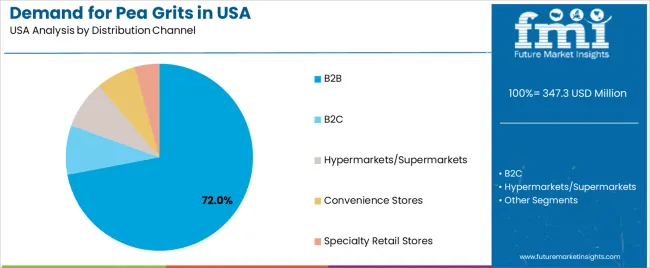
The B2B (business-to-business) distribution channel accounts for 72% of the demand for pea grits in the USA. B2B channels dominate due to the widespread use of pea grits in large-scale food production and processing. Manufacturers, food producers, and suppliers rely on bulk purchases of pea grits for use in a variety of applications, including snacks, plant-based foods, and dietary supplements.
The B2B distribution model ensures a steady and cost-efficient supply of pea grits to these businesses, allowing them to meet the growing demand for plant-based products in the industry. Additionally, B2B relationships often involve long-term contracts and larger order volumes, making them more stable and profitable for suppliers. As the demand for plant-based and protein-enriched products continues to rise, B2B distribution remains the dominant channel for the supply of pea grits to food manufacturers, reinforcing its position as the leading channel in the USA.
Pea grits ingredients provide high‑protein, gluten‑free, and allergen‑friendly options that align with clean‑label and flexitarian consumer trends. A key driver is the expanding plant‑based food industry coupled with reformulation of traditional foods for higher nutritional content. Restraints include supply‑chain variability (pulses vs major crops), cost pressures of specialty processing, and educational gaps among formulators regarding functional use of pea grits.
Demand in the USA is growing because manufacturers are seeking versatile, sustainable ingredient options to meet consumer demands for protein‑rich, plant‑based, and clean‑label products. Pea grits coarser‑milled pulse fragments serve as functional ingredients in meat analogues, cereal‑bars, bakery, and snack formulations, enabling manufacturers to boost protein levels while avoiding major allergens like soy or dairy. The rise in flexitarian and vegan diets, combined with the need for textural and nutritional improvements in plant‑based foods, is making pea grits an attractive formulation choice. As food‑tech and ingredient supply chains mature, USA adoption is increasing across industrial applications.
Innovations are fueling growth by improving the processing, functionality, and application reach of pea grits. Advances in milling technology allow finer control of particle size and removal of off‑flavour compounds, enabling cleaner taste profiles in consumer goods. Improved separation and fractionation methods enhance protein content and improve solubility or dispersibility for use in snacks or bakery products. Ingredient suppliers are also introducing pre‑blended grits with complementary ingredients (fibres, flavour carriers) to simplify formulation. These developments reduce barriers for food‑manufacturers and increase pea grits uptake in mainstream categories beyond niche plant‑based lines.
Despite strong potential, several factors limit broader adoption of pea grits in the USA One major issue is cost and supply variability pulse crops receive less scale compared to soy or corn, which can make pea‑grit production costlier and subject to raw‑material fluctuations. Texture and sensory considerations pose another challenge, as coarser‑milled pulse fragments may impart gritty mouth‑feel or pea‑like flavour if not finely processed, thereby limiting use in premium formulations. Formulator awareness and specification inertia can slow adoption: manufacturers accustomed to established ingredients may hesitate to reformulate around pea grits without clear performance or cost justification. Overcoming those challenges will be key for pea grits to achieve wider penetration across USA food categories.
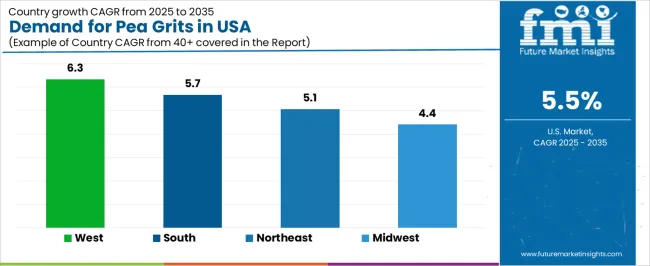
| Region | CAGR (%) |
|---|---|
| West | 6.3% |
| South | 5.7% |
| Northeast | 5.1% |
| Midwest | 4.4% |
The demand for pea grits in the USA is growing steadily, with the West leading at a 6.3% CAGR. This growth is primarily driven by the increasing consumer demand for plant-based, gluten-free, and high-protein food products. The South follows with a 5.7% CAGR, driven by an expanding food processing industry and the growing adoption of pea-based ingredients in food manufacturing. The Northeast records a 5.1% CAGR, supported by the region's strong focus on health-conscious food options and alternative protein sources. The Midwest, while growing at a more moderate 4.4%, continues to see steady demand as the food and beverage sector seeks innovative, plant-based ingredients.
The West leads the demand for pea grits in the USA, with a 6.3% CAGR. The region’s health-conscious and environmentally aware consumer base is a key driver of this growth. States like California and Washington are known for their focus on plant-based, gluten-free, and sustainable food products. Pea grits, a natural source of protein and fiber, are increasingly used in a variety of applications, from snacks to plant-based meat alternatives, making them a popular ingredient in the region’s thriving health food industry.
The West’s large-scale adoption of plant-based diets and alternative protein sources further supports the growth of pea grits. With growing awareness of the environmental impact of animal-based products, consumers are seeking sustainable, high-protein alternatives, such as pea-based ingredients. The region’s food industry, known for its innovation and commitment to clean-label, eco-friendly products, continues to push the demand for pea grits. As more food manufacturers seek to meet consumer demand for plant-based solutions, the use of pea grits will continue to rise in the West.
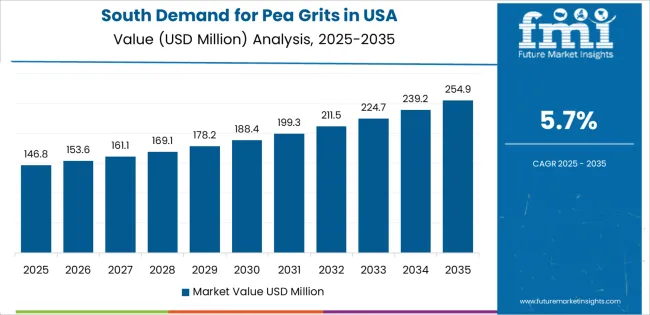
The South is witnessing steady growth in the demand for pea grits, with a 5.7% CAGR. The region’s growing food processing and manufacturing sectors are key contributors to this trend. States like Texas, Georgia, and Florida are home to many food manufacturers who are incorporating pea grits into their products as a gluten-free and plant-based alternative to traditional ingredients. Pea grits are increasingly used in food applications ranging from snacks and bakery products to meat alternatives, boosting their demand.
The increasing consumer awareness of the health benefits of plant-based proteins, such as high fiber content and low fat, is contributing to the growing adoption of pea grits in the South. The region’s food industry is responding to the demand for healthier, more sustainable food options by incorporating innovative ingredients like pea grits. As the trend toward plant-based eating continues to gain traction, the use of pea grits in food manufacturing and processing will continue to grow in the South.
The Northeast is experiencing moderate growth in the demand for pea grits, with a 5.1% CAGR. The region’s focus on health-conscious living and alternative protein sources is a major driver of this trend. Cities like New York and Boston are hubs for health food trends and plant-based diets, where pea grits are increasingly used in both consumer food products and manufacturing. The growing demand for gluten-free, high-protein ingredients in the Northeast’s food industry is contributing to the rise of pea grits as a key ingredient.
The Northeast’s strong presence in the food innovation and sustainability sectors is helping to boost the demand for pea-based ingredients. Consumers in this region are becoming more aware of the environmental impact of their food choices, leading to an increased demand for plant-based ingredients that have a lower environmental footprint than animal-based products. As more food companies and consumers prioritize sustainability and health, pea grits are becoming an integral part of the region’s food offerings.
The Midwest is experiencing steady growth in the demand for pea grits, with a 4.4% CAGR. The region’s strong agricultural base and the rise in plant-based food production are contributing to this demand. States like Illinois, Michigan, and Ohio have large-scale food manufacturing industries that are increasingly adopting pea grits as a versatile, plant-based ingredient. These grits are used in a wide range of products, from gluten-free snacks to plant-based meat alternatives, making them a valuable ingredient for manufacturers.
Although growth in the Midwest is slower compared to other regions, the demand for pea grits is steadily increasing as consumers and manufacturers continue to embrace plant-based alternatives. The region’s focus on innovative, eco-friendly food solutions and its growing interest in plant-based eating are expected to drive the continued use of pea grits in food products. As the food industry in the Midwest evolves to meet the needs of health-conscious and environmentally aware consumers, the demand for pea grits will likely continue to rise.
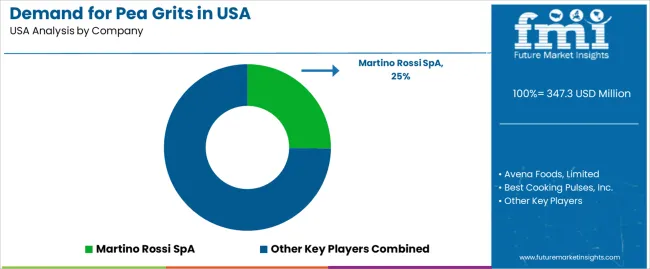
The demand for pea grits in the United States is being driven by growing interest in plant‑based proteins, clean‑label ingredients, and versatile food formulations. Pea grits coarse fragments of peas that retain high protein and fiber content, are increasingly used in food processing applications, including meat alternatives, snacks, cereal products, and fortified foods. USA manufacturers are leveraging pea grits for their functional benefits (such as texture and binding) as well as their nutritional profile.
In the USA demand landscape, Martino Rossi SpA leads with an estimated 25.2% share, reflecting its strong reach in supplying pea grits or processing services that support USA food manufacturers. Other significant contributors include Avena Foods, Limited, Best Cooking Pulses, Inc., ADM, and Ingredion, each supplying pea grits to meet the needs of food and snack producers seeking plant‑based ingredients and functional nutrition.
Key factors fueling demand include the expanding industry for plant‑based and vegan foods, the need for gluten‑free and allergen‑friendly ingredients, and the growing adoption of pea‑based proteins within the formulation of high‑protein snacks and meals. Pea grits offer cost‑effective alternative protein sources and a favorable ingredient profile for food brands aiming to meet current consumer preferences. While growth is strong, challenges such as price fluctuations in raw peas, competition from other pulse‑based ingredients and the need for consistent supply and quality may temper some uptake. Overall, the demand for pea grits in the USA remains robust, supported by the ongoing shift toward nutritious, plant‑based food systems.
| Items | Values |
|---|---|
| Quantitative Units | USD million |
| Product Type | Yellow Pea Grits, Green Pea Grits |
| End Use | Food Processing, Poultry Feeds, Food Services, Households, Others |
| Flavor | Sweet, Savory |
| Distribution Channel | B2B, B2C, Hypermarkets/Supermarkets, Convenience Stores, Specialty Retail Stores |
| Regions Covered | West, South, Northeast, Midwest |
| Key Players Profiled | Martino Rossi SpA, Avena Foods, Limited, Best Cooking Pulses, Inc., ADM, Ingredion |
| Additional Attributes | Dollar sales by product type, end-use, flavor, and distribution channel categories, regional adoption trends, competitive landscape, advancements in pea grits processing technologies, integration with food and feed industries. |
The global demand for pea grits in USA is estimated to be valued at USD 347.3 million in 2025.
The market size for the demand for pea grits in USA is projected to reach USD 593.2 million by 2035.
The demand for pea grits in USA is expected to grow at a 5.5% CAGR between 2025 and 2035.
The key product types in demand for pea grits in USA are yellow pea grits and green pea grits.
In terms of end use, food processing segment to command 47.0% share in the demand for pea grits in USA in 2025.






Our Research Products

The "Full Research Suite" delivers actionable market intel, deep dives on markets or technologies, so clients act faster, cut risk, and unlock growth.

The Leaderboard benchmarks and ranks top vendors, classifying them as Established Leaders, Leading Challengers, or Disruptors & Challengers.

Locates where complements amplify value and substitutes erode it, forecasting net impact by horizon

We deliver granular, decision-grade intel: market sizing, 5-year forecasts, pricing, adoption, usage, revenue, and operational KPIs—plus competitor tracking, regulation, and value chains—across 60 countries broadly.

Spot the shifts before they hit your P&L. We track inflection points, adoption curves, pricing moves, and ecosystem plays to show where demand is heading, why it is changing, and what to do next across high-growth markets and disruptive tech

Real-time reads of user behavior. We track shifting priorities, perceptions of today’s and next-gen services, and provider experience, then pace how fast tech moves from trial to adoption, blending buyer, consumer, and channel inputs with social signals (#WhySwitch, #UX).

Partner with our analyst team to build a custom report designed around your business priorities. From analysing market trends to assessing competitors or crafting bespoke datasets, we tailor insights to your needs.
Supplier Intelligence
Discovery & Profiling
Capacity & Footprint
Performance & Risk
Compliance & Governance
Commercial Readiness
Who Supplies Whom
Scorecards & Shortlists
Playbooks & Docs
Category Intelligence
Definition & Scope
Demand & Use Cases
Cost Drivers
Market Structure
Supply Chain Map
Trade & Policy
Operating Norms
Deliverables
Buyer Intelligence
Account Basics
Spend & Scope
Procurement Model
Vendor Requirements
Terms & Policies
Entry Strategy
Pain Points & Triggers
Outputs
Pricing Analysis
Benchmarks
Trends
Should-Cost
Indexation
Landed Cost
Commercial Terms
Deliverables
Brand Analysis
Positioning & Value Prop
Share & Presence
Customer Evidence
Go-to-Market
Digital & Reputation
Compliance & Trust
KPIs & Gaps
Outputs
Full Research Suite comprises of:
Market outlook & trends analysis
Interviews & case studies
Strategic recommendations
Vendor profiles & capabilities analysis
5-year forecasts
8 regions and 60+ country-level data splits
Market segment data splits
12 months of continuous data updates
DELIVERED AS:
PDF EXCEL ONLINE
Demand Signal Repository Solutions Market Size and Share Forecast Outlook 2025 to 2035
Demand Side Management Market Size and Share Forecast Outlook 2025 to 2035
Demand Response Market Analysis - Size, Share, and Forecast Outlook 2025 to 2035
North America Shipping Supplies Market Trends – Innovations & Growth 2024-2034
Demand of Kozani Saffron in Greece Analysis - Size, Share & Forecast 2025 to 2035
Demand of No-acid Whey Strained Dairy Processing Concepts in European Union Size and Share Forecast Outlook 2025 to 2035
Demand for Bronte Pistachio in Italy Analysis - Size, Share & Forecast 2025 to 2035
Demand and Trend Analysis of Gaming Monitor in Western Europe Size and Share Forecast Outlook 2025 to 2035
Demand and Trend Analysis of Gaming Monitor in Japan Size and Share Forecast Outlook 2025 to 2035
Demand and Trend Analysis of Gaming Monitor in Korea Size and Share Forecast Outlook 2025 to 2035
Glycine Soja (Soybean) Seed Extract Market Size and Share Forecast Outlook 2025 to 2035
Demand and Trend Analysis of Yeast in Japan - Size, Share, and Forecast Outlook 2025 to 2035
Demand and Trends Analysis of Stevia in Japan Size and Share Forecast Outlook 2025 to 2035
Demand of Pistachio-based desserts & ingredients in France Analysis - Size, Share & Forecast 2025 to 2035
Japan Women’s Intimate Care Market Trends – Growth & Forecast 2024-2034
Western Europe Men’s Skincare Market Analysis – Forecast 2023-2033
Demand and Trend Analysis of Fabric Stain Remover in Korea Size and Share Forecast Outlook 2025 to 2035
Demand and Sales Analysis of Paper Cup in Japan Size and Share Forecast Outlook 2025 to 2035
Demand and Sales Analysis of Paper Cup in Korea Size and Share Forecast Outlook 2025 to 2035
Demand and Sales Analysis of Paper Cup in Western Europe Size and Share Forecast Outlook 2025 to 2035

Thank you!
You will receive an email from our Business Development Manager. Please be sure to check your SPAM/JUNK folder too.
Chat With
MaRIA